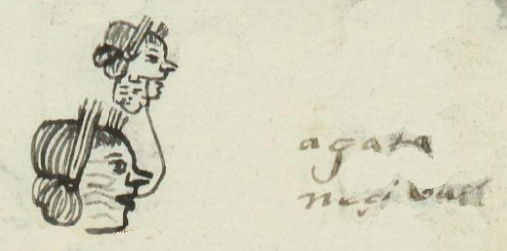Nencihuatl (MH633r)
This black-line drawing of the compound glyph for the personal name Nencihuatl (perhaps "Useless Woman") is attested here as a woman's name. It is a profile view of a woman looking toward the viewer's right. She wears the classic hairstyle (neaxtlahualli) that married sedentary women (cihuatl) wore (with the hair twisted up into two points above their foreheads). But this shape on the head also echoes the rectangular points recalling the doll or deity image (nenetl) that is so common in the Matrícula de Huexotzinco, providing the "nen-" syllable. This nen- syllable seems to be a negative in most cases.
Stephanie Wood
Nencihuatl is found in the dictionary, but necihuatl is not. A dropping of the letter "n" is not at all unusual; so perhaps it should be there, even though it does not appear in the gloss.
The five extra days in the calendar of 360 days (xiuhpohualli) were called nemontemi (useless days). It was unlucky to be born on these days. A man who was born in this period was called nenoquich and a woman was called nencihuatl. This is explained in the Florentine Codex in Book 2, folio 12 recto (see: https://florentinecodex.getty.edu/book/2/folio/12r). These individuals were considered unlucky, ill-fated, and even useless. A great many individuals in the Matrícula de Huexotzinco have names beginning with the negative syllable Nen-. Perhaps they were born in that ill-fated period, or perhaps the negative syllable came to be even more liberally applied. With men, for instance, Nentequitl (perhaps a lazy worker) was much more common than Nenoquich. When presented visually, the nen- syllable could derive from nenetl (a figure or sculpture of a deity or a doll). Nenetl also had an association with women’s genitals, which has caused much speculation about a negativity associated with women and their sex, but that might have come from European religious influence. In the colonial context, such concepts and perceptions could become muddied.
Stephanie Wood
agata
neçivatl
Ágata Nencihuatl
Stephanie Wood
1560
Jeff Haskett-Wood
women, mujeres, dolls, muñecas, deidades, esculturas, figuras, calendarios, xiuhpohualli, nombres de mujeres, nombres negativos, axtlacuilli

nencihuatl, a woman born during nemontemi (five extra calender days, a time of uselessness), https://nahuatl.wired-humanities.org/content/nencihuatl
cihua(tl), woman, https://nahuatl.wired-humanities.org/content/cihuatl
nen-, in vain, uselessly, for nothing, https://nahuatl.wired-humanities.org/content/nen
nene(tl), deity image, doll, or female genitals, https://nahuatl.wired-humanities.org/content/nenetl
Mujer Inútil
Stephanie Wood
Matrícula de Huexotzinco, folio 633r, World Digital Library, https://www.loc.gov/resource/gdcwdl.wdl_15282/?sp=348.
This manuscript is hosted by the Library of Congress and the World Digital Library; used here with the Creative Commons, “Attribution-NonCommercial-ShareAlike 3.0 License” (CC-BY-NC-SAq 3.0).









